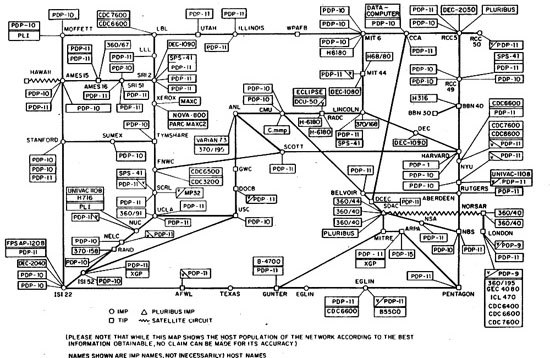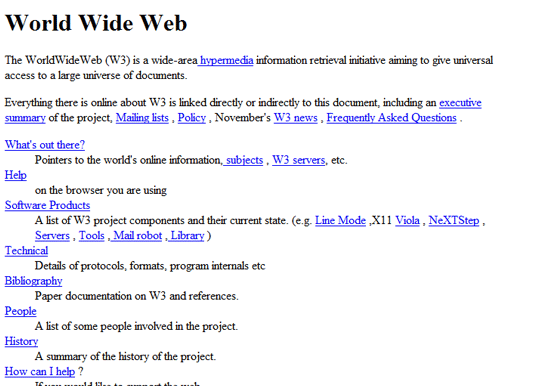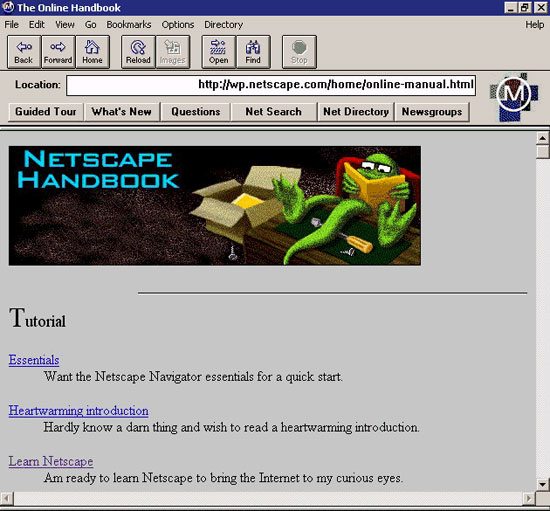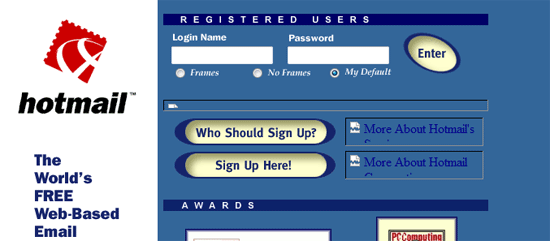-
 Published: Jun 12, 2023
Published: Jun 12, 2023
-
 23 min. read
23 min. read
-
 William Craig
William Craig CEO & Co-Founder
CEO & Co-Founder
- President of WebFX. Bill has over 25 years of experience in the Internet marketing industry specializing in SEO, UX, information architecture, marketing automation and more. William’s background in scientific computing and education from Shippensburg and MIT provided the foundation for RevenueCloudFX and other key research and development projects at WebFX.
Key Takeaways
- Major internet innovations transformed not only the web but society as a whole.
- Key milestones include the development of email, the creation of the World Wide Web, the introduction of social media platforms, and the launch of the iPhone.
The Internet has become a prominent part of every day life. From searching for recipes to make dinner to buying new products for your bedroom to watching your favorite shows, the Internet has become an integral part of our daily routines.
But it hasn’t always been as refined as it is today. The Internet timeline is an intricate and complex development that has led to the Internet as we know it today.
Keep reading to learn a brief history of the Internet. And don’t forget to subscribe to our newsleter for the latest information on all things digital marketing!
1969: Arpanet
Arpanet was the first real network to run on packet switching technology (new at the time).
On October 29, 1969, computers at Stanford and UCLA connected for the first time. In effect, they were the first hosts on what would one day become the Internet. The first message sent across the network was supposed to be “Login”, but reportedly, the link between the two colleges crashed on the letter “g”.
1969: Unix

Another major milestone during the 60’s was the inception of Unix: the operating system whose design heavily influenced that of Linux and FreeBSD (the operating systems most popular in today’s web servers/web hosting services).
1970: Arpanet network
An Arpanet network was established between Harvard, MIT, and BBN (the company that created the “interface message processor” computers used to connect to the network) in 1970.
1971: Email
Email was first developed in 1971 by Ray Tomlinson, who also made the decision to use the “@” symbol to separate the user name from the computer name (which later on became the domain name).
1971: Project Gutenberg and eBooks
One of the most impressive developments of 1971 was the start of Project Gutenberg. Project Gutenberg, for those unfamiliar with the site, is a global effort to make books and documents in the public domain available electronically–for free–in a variety of eBook and electronic formats.
It began when Michael Hart gained access to a large block of computing time and came to the realization that the future of computers wasn’t in computing itself, but in the storage, retrieval and searching of information that, at the time, was only contained in libraries.
He manually typed (no OCR at the time) the “Declaration of Independence” and launched Project Gutenberg to make information contained in books widely available in electronic form. In effect, this was the birth of the eBook.
1972: CYCLADES
France began its own Arpanet-like project in 1972, called CYCLADES. While Cyclades was eventually shut down, it did pioneer a key idea: the host computer should be responsible for data transmission rather than the network itself.
1973: The first trans-Atlantic connection and the popularity of emailing
Arpanet made its first trans-Atlantic connection in 1973, with the University College of London. During the same year, email accounted for 75% of all Arpanet network activity.
1974: The beginning of TCP/IP

1974 was a breakthrough year. A proposal was published to link Arpa-like networks together into a so-called “inter-network”, which would have no central control and would work around a transmission control protocol (which eventually became TCP/IP).
1975: The email client
With the popularity of emailing, the first modern email program was developed by John Vittal, a programmer at the University of Southern California in 1975. The biggest technological advance this program (called MSG) made was the addition of “Reply” and “Forward” functionality.
1977: The PC modem
1977 was a big year for the development of the Internet as we know it today. It’s the year the first PC modem, developed by Dennis Hayes and Dale Heatherington, was introduced and initially sold to computer hobbyists.
1978: The Bulletin Board System (BBS)
The first bulletin board system (BBS) was developed during a blizzard in Chicago in 1978.
1978: Spam is born
1978 is also the year that brought the first unsolicited commercial email message (later known as spam), sent out to 600 California Arpanet users by Gary Thuerk.
1979: MUD – The earliest form of multiplayer games

The precursor to World of Warcraft and Second Life was developed in 1979, and was called MUD (short for MultiUser Dungeon). MUDs were entirely text-based virtual worlds, combining elements of role-playing games, interactive, fiction, and online chat.
1979: Usenet
1979 also ushered into the scene: Usenet, created by two graduate students. Usenet was an internet-based discussion system, allowing people from around the globe to converse about the same topics by posting public messages categorized by newsgroups.
1980: ENQUIRE software
The European Organization for Nuclear Research (better known as CERN) launched ENQUIRE (written by Tim Berners-Lee), a hypertext program that allowed scientists at the particle physics lab to keep track of people, software, and projects using hypertext (hyperlinks).
1982: The first emoticon
While many people credit Kevin MacKenzie with the invention of the emoticon in 1979, it was Scott Fahlman in 1982 who proposed using 🙂 after a joke, rather than the original -) proposed by MacKenzie. The modern emoticon was born.
1983: Arpanet computers switch over to TCP/IP
January 1, 1983 was the deadline for Arpanet computers to switch over to the TCP/IP protocols developed by Vinton Cerf. A few hundred computers were affected by the switch. The name server was also developed in ’83.
1984: Domain Name System (DNS)
The domain name system was created in 1984 along with the first Domain Name Servers (DNS).
The domain name system was important in that it made addresses on the Internet more human-friendly compared to its numerical IP address counterparts. DNS servers allowed Internet users to type in an easy-to-remember domain name and then converted it to the IP address automatically.
1985: Virtual communities
1985 brought the development of The WELL (short for Whole Earth ‘Lectronic Link), one of the oldest virtual communities still in operation.
It was developed by Stewart Brand and Larry Brilliant in February of ’85. It started out as a community of the readers and writers of the Whole Earth Review and was an open but “remarkably literate and uninhibited intellectual gathering”.
Wired Magazine once called The Well “The most influential online community in the world.”
1986: Protocol wars
The so-called Protocol wars began in 1986. European countries at that time were pursuing the Open Systems Interconnection (OSI), while the United States was using the Internet/Arpanet protocol, which eventually won out.
1987: The Internet grows
By 1987, there were nearly 30,000 hosts on the Internet. The original Arpanet protocol had been limited to 1,000 hosts, but the adoption of the TCP/IP standard made larger numbers of hosts possible.
1988: IRC – Internet Relay Chat
Also in 1988, Internet Relay Chat (IRC) was first deployed, paving the way for real-time chat and the instant messaging programs we use today.
1988: First major malicious internet-based attack
One of the first major Internet worms was released in 1988. Referred to as “The Morris Worm”, it was written by Robert Tappan Morris and caused major interruptions across large parts of the Internet.
1989: AOL is launched
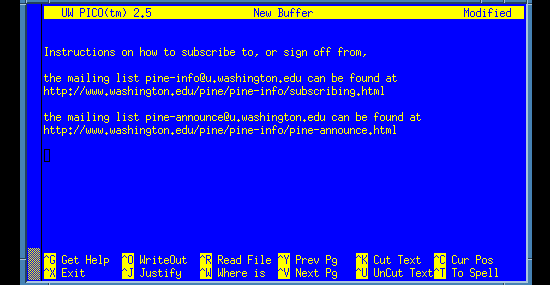
When Apple pulled out of the AppleLink program in 1989, the project was renamed and America Online was born. AOL later made the Internet popular amongst the average internet users.
1989: The proposal for the World Wide Web
1989 also brought about the proposal for the World Wide Web, written by Tim Berners-Lee.
It was originally published in the March issue of MacWorld, and then redistributed in May 1990. It was written to persuade CERN that a global hypertext system was in CERN’s best interest. It was originally called “Mesh”; the term “World Wide Web” was coined while Berners-Lee was writing the code in 1990.
1990: First commercial dial-up ISP
1990 also brought about the first commercial dial-up Internet provider, The World. The same year, Arpanet ceased to exist.
1990: World Wide Web protocols finished
The code for the World Wide Web was written by Tim Berners-Lee, based on his proposal from the year before, along with the standards for HTML, HTTP, and URLs.
1990: The first search engine
Also in 1990, Alan Emtage, a college student in Montreal, created the first search engine for a school project. The search engine was known as the Archie Index.
1990s: The first photo shared on the Internet
Remember Tim Berners-Lee? He’s making waves again, sharing the first photo on the Internet. It featured a group of singers known as Les Horribles Cernettes.
1991: First web page created
1991 brought some major innovations to the world of the Internet. The first web page was created and, much like the first email explained what email was, its purpose was to explain what the World Wide Web was.
1991: First content-based search protocol
Also in the same year, the first search protocol that examined file contents instead of just file names was launched, called Gopher.
1991: MP3 becomes a standard
Also, the MP3 file format was accepted as a standard in 1991. MP3 files, being highly compressed, later become a popular file format to share songs and entire albums via the internet.
1991: The first webcam

One of the more interesting developments of this era, though, was the first webcam. It was deployed at a Cambridge University computer lab, and its sole purpose was to monitor a particular coffee maker so that lab users could avoid wasted trips to an empty coffee pot.
1993: Mosaic – first graphical web browser for the general public
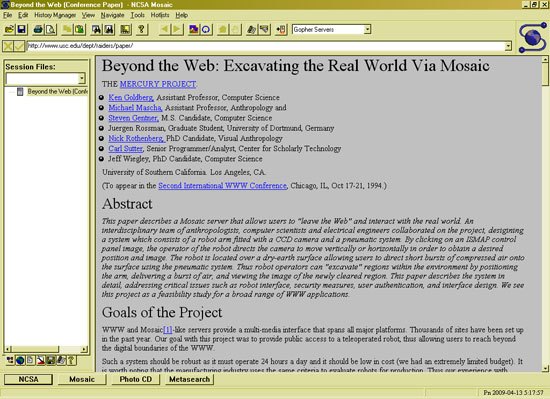
The first widely downloaded Internet browser, Mosaic, was released in 1993. While Mosaic wasn’t the first web browser, it is considered the first browser to make the Internet easily accessible to non-techies.
1993: Governments join in on the fun
In 1993, both the White House and the United Nations came online, marking the beginning of the .gov and .org domain names.
1994: Netscape Navigator
Mosaic’s first big competitor, Netscape Navigator, was released the year following (1994).
1994: The first secure ecommerce transaction
Where would the world be without ecommerce? We can trace secure online transactions back to 1994, when the first item was purchased securely online.
The item may have been a Sting CD, sold for $12.48 on Dan Kohn’s NetMarket. However, the Internet Shopping Network suggests they completed an online transaction for computer equipment a month prior to this CD purchase.
1995: Commercialization of the Internet
Following the first secure Internet transactions, 1995 is often considered the first year the web became commercialized.
While there were commercial enterprises online prior to ’95, there were a few key developments that happened that year. First, SSL (Secure Sockets Layer) encryption was developed by Netscape, making it safer to conduct financial transactions (like credit card payments) online.
In addition, two major online businesses got their start the same year. The first sale on “Echo Bay” was made that year. Echo Bay later became eBay. Amazon.com also started in 1995, though it didn’t turn a profit for six years, until 2001.
1995: The development of cryptocurrency
What better way to complement ecommerce than with the invention of cryptocurrency? David Chaum, a computer scientist and cryptographer, created DigiCash in 1995, which went on to pave the way for Bitcoin and other forms of digital money.
1995: Geocities, the Vatican goes online, and JavaScript
Other major developments that year included the launch of Geocities (which officially closed down on October 26, 2009). The Vatican also went online for the first time. Java and JavaScript (originally called LiveScript by its creator, Brendan Eich, and deployed as part of the Netscape Navigator browser – see comments for explanation) was first introduced to the public in 1995. ActiveX was launched by Microsoft the following year.
1996: First web-based (webmail) service
In 1996, HoTMaiL (the capitalized letters are an homage to HTML), the first webmail service, was launched.
1996: The creation of social media
Beyond webmail, the Internet also gets more social in 1996 with the creation of the first social media platform. Andrew Weinreich created Six Degrees, which features all our favorite social media hallmarks, including individual profiles and connections with friends.
1997: The invention of Wi-Fi
Today, Wi-Fi is almost synonymous with the Internet, and we can trace its official creation back to 1997. In this year, the Institute of Electrical and Electronics Engineers (IEEE) approved the 802.11 standard for Wi-Fi.
This “official” onset came after several foundational developments, leading back to the 1940s, when actress Hedy Lamarr and George Antheil developed a “frequency hopping” system.
The system paved the way for a team at CSIRO to invent the Wireless Local Area Network (WLAN) in the 1990s. The WLAN allowed devices to connect to a network through radio waves.
1997: The term “weblog” is coined
While the first blogs had been around for a few years in one form or another, 1997 was the first year the term “weblog” was used.
1998: First new story to be broken online instead of traditional media
In 1998, the first major news story to be broken online was the Bill Clinton/Monica Lewinsky scandal (also referred to as “Monicagate” among other nicknames), which was posted on The Drudge Report after Newsweek killed the story.
1998: Google!
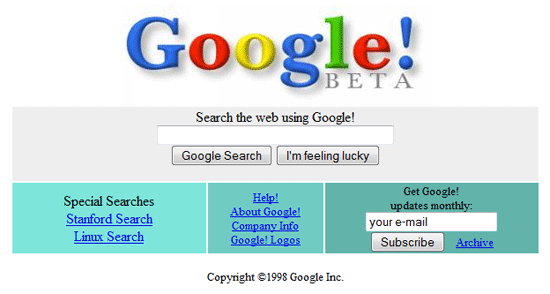
Google went live in 1998, revolutionizing the way in which people find information online.
1998: Internet-based file-sharing gets its roots
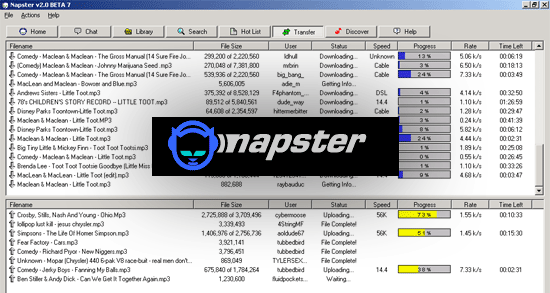
In 1998 as well, Napster launched, opening up the gates to mainstream file-sharing of audio files over the internet.
1999: SETI@home project
1999 is the year when one of the more interesting projects ever brought online: the SETI@home project, launched. The project has created the equivalent of a giant supercomputer by harnessing the computing power of more than 3 million computers worldwide, using their processors whenever the screensaver comes on, indicating that the computer is idle.
The program analyzes radio telescope data to look for signs of extraterrestrial intelligence.
2000: The bubble bursts
2000 was the year of the dotcom collapse, resulting in huge losses for legions of investors.
Hundreds of companies closed, some of which had never turned a profit for their investors. The NASDAQ, which listed a large number of tech companies affected by the bubble, peaked at over 5,000, then lost 10% of its value in a single day, and finally hit bottom in October of 2002.
2001: Wikipedia is launched
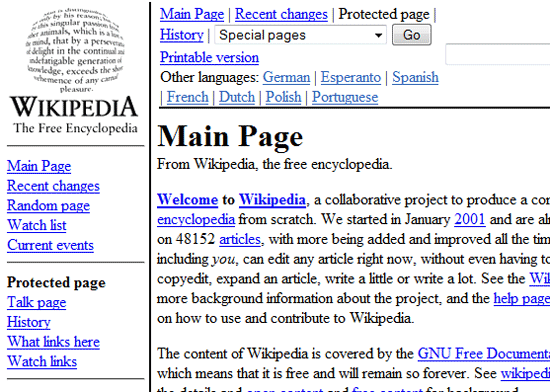
With the dotcom collapse still going strong, Wikipedia launched in 2001, one of the websites that paved the way for collective web content generation/social media.
2003: VoIP goes mainstream
In 2003: Skype is released to the public, giving a user-friendly interface to Voice over IP calling.
2003: MySpace becomes the most popular social network
Also in 2003, MySpace opens up its doors. It later grew to be the most popular social network at one time (though it has since been overtaken by Facebook).
2003: CAN-SPAM Act puts a lid on unsolicited emails
Another major advance in 2003 was the signing of the Controlling the Assault of Non-Solicited Pornography and Marketing Act of 2003, better known as the CAN-SPAM Act.
2004: Web 2.0
Though coined in 1999 by Darcy DiNucci, the term “Web 2.0”, referring to websites and Rich Internet Applications (RIA) that are highly interactive and user-driven became popular around 2004.
During the first Web 2.0 conference, John Batelle and Tim O’Reilly described the concept of “the Web as a Platform“: software applications built to take advantage of internet connectivity, moving away from the desktop (which has downsides such as operating system dependency and lack of interoperability).
2004: Social Media and Digg
The term “social media”, believed to be first used by Chris Sharpley, was coined in the same year that “Web 2.0” became a mainstream concept.
Social media–sites and web applications that allow its users to create and share content and to connect with one another–started around this period. People loved the idea of being able to travel through their friends and families pictures and adventures, despite not being physically present.

Digg, a social news site, launched on November of 2004, paving the way for sites such as Reddit, Mixx, and Yahoo! Buzz. Digg revolutionized traditional means of generating and finding web content, democratically promoting news and web links that are reviewed and voted on by a community.
2004: “The” Facebook opens to college students
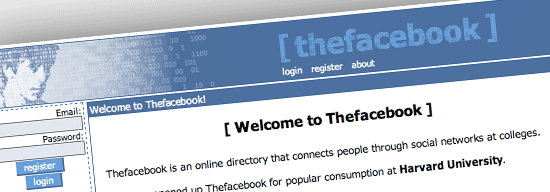
Facebook launched in 2004, though at the time it was only open to college students and was called “The Facebook”; later on, “The” was dropped from the name, though the URL http://www.thefacebook.com still works.
2005: YouTube – streaming video for the masses
YouTube launched in 2005, bringing free online video hosting and sharing to the masses.
2006: Twitter gets twittering
Twitter launched in 2006. It was originally going to be called twittr (inspired by Flickr); the first Twitter message was “just setting up my twttr”.
2007: Major move to place TV shows online

Hulu was first launched in 2007, a joint venture between ABC, NBC, and Fox to make popular TV shows available to watch online.
2007: The iPhone and the Mobile Web

The biggest innovation of 2007 was almost certainly the iPhone, which was almost wholly responsible for renewed interest in mobile web applications and design.
2008: “Internet Election”
The first “Internet election” took place in 2008 with the U.S. Presidential election. It was the first year that national candidates took full advantage of all the Internet had to offer. Hillary Clinton jumped on board early with YouTube campaign videos. Virtually every candidate had a Facebook page or a Twitter feed, or both.
Ron Paul set a new fundraising record by raising $4.3 million in a single day through online donations, and then beat his own record only weeks later by raising $4.4 million in a single day. The 2008 elections placed the Internet squarely at the forefront of politics and campaigning, a trend that is unlikely to change any time in the near future.
2008: The beginning of Bitcoin
Remember the invention of cryptocurrency back in 1995? Fast forward to 2008, and you see the beginning of Bitcoin — specifically, the domain name bitcoin.org.
After this domain appeared online, someone — or a group of people — using the pseudonym Satoshi Nakamoto sent out a whitepaper on Bitcoin to a cryptography mailing list.
2009: ICANN policy changes
2009 brought about one of the biggest changes to come to the Internet in a long time when the U.S. relaxed its control over ICANN, the official naming body of the Internet (they’re the organization in charge of registering domain names).
2010: The first commercial transaction using Bitcoin
Two years after the beginning of Bitcoin, the first commercial transaction was made with the cryptocurrency. The transaction, which occurred in Florida, was for two Papa John’s pizzas costing 10,000 BTC (Bitcoins).
2010: Instagram captures a new audience
With social media continuing to rise in popularity, more platforms popped up on the Internet. In 2010, the photo-sharing platform Instagram came on to the scene.
2010: Pinterest gets people pinning
The 2000s were an increasingly popular time to launch social media platforms. Along with Instagram, Pinterest launched in 2010 to get people pinning and sharing recipes, crafts, and more.
2010: HBO starts streaming
With platforms like Netflix and Hulu seeing success with streaming content online, HBO began to shift their content distribution online. In 2010, HBO launched HBO Go as their online streaming service.
2011: Snapchat caters to shortening attention spans
The average attention span has dropped by 4 seconds since 2000 (it’s now 8.25 seconds). Snapchat, with it’s 10-second snaps, became an appealing social platform for people with shortening attention spans.
2011: Microsoft buys Skype
In 2011, Microsoft purchased Skype, the online video chatting platform that enables people to video chat online.
2011: Adobe Creative Cloud is introduced
In 2011, the Adobe Creative Cloud was introduced. This took their disk-based software and put it online, allowing them to continually update and improve their software.
2013: Twitter tries video with Vine
With more people consuming video content, Twitter took advantage of the interest in this popular format. Twitter created Vine, the six-second video platform.
2013: Internet banking becomes mainstream
In 2013, more people started banking online. Ten years later, 78% of Americans prefer to bank online.
2014: Facebook purchases WhatsApp
With Facebook continuing to experience success, they purchased the messaging app WhatsApp to help expand their global communication efforts.
2015: FCC boasts net neutrality
In 2015, the FCC ruled in favor of net neutrality to keep the Internet free and open for everyone. The ruling was upheld by a federal court of appeals in 2016.
2015: Live streaming starts
With video becoming an increasingly popular way to consume content, live streaming was created. In 2015, Facebook launched Facebook Live and Twitter purchased Periscope, a live streaming app.
2016: TikTok dances to the top
TikTok came to the scene in 2016, capturing attention of users across the globe. This platform became a hub for creating video content to share with others.
2016: Google launches their voice assistant
With technology continuing to develop, more companies turned to voice assistive devices to create a better online experience. In 2016, Google launched their voice assistant through their Google Nest device and their Apollo app.
2016: Pokemon Go makes everyone want to catch them all
In 2016, Pokemon Go became a global phenomenon that took the Internet by storm. It brought augmented reality (AR) to the forefront.
2018: Data privacy takes center stage with GDPR
With increased concerns over data privacy, some countries started to focus on protecting user data. In 2018, the EU solidified data protection with the General Data Protection Regulation (GDPR).
2019: 5G rolls out
As the Internet continued to develop, companies focused on delivering better Internet services. By 2019, 5G rolled out to the public as a new way to connect online.
2020: The shift towards remote working
With the COVID-19 pandemic, people shifted to working from home, which meant working online. As a result, things like video chatting software, productivity management programs, and online collaboration spaces grew in popularity.
2021: The rise of NFTs
In 2021, Non-Fungible Tokens (NFTs) became a popular way for people to buy and sell digital art and collectibles.
2022: ChatGPT launches
In 2022, ChatGPT officially launched. This artificial intelligence (AI) platform helps people generate texts, gather information, and more.
Future of Internet
There’s no doubt that the Internet will continue to envolve as time goes on. So, what will happen next? With technologies like AI and voice search devices continuing to rise in popularity, this technology will continue to develop and become more integral.
As for what else we’ll see in the future, only time will tell.
Sources and Further Reading
- A People’s History of the Internet: from Arpanet in 1969 to Today: A timeline of the Internet from guardian.co.uk.
- History of the Internet: An early timeline of the Internet, from precursors in the 1800s up through 1997.
- A Brief History of the Web: A series of videos from Microsoft to celebrate the launch of Internet Explorer 8.
- The History of the Internet – Tim Berners-Lee: A brief history of major developments associated with the Internet from About.com.
- Hobbes’ Internet Timeline – the definitive ARPAnet & Internet History: A very thorough timeline of the Internet, starting in 1957 and going up through 2004, with tons of statistics and source material included.
- Internet Timeline: A basic timeline of Internet history from FactMonster.com.
Related Content
-
 President of WebFX. Bill has over 25 years of experience in the Internet marketing industry specializing in SEO, UX, information architecture, marketing automation and more. William’s background in scientific computing and education from Shippensburg and MIT provided the foundation for RevenueCloudFX and other key research and development projects at WebFX.
President of WebFX. Bill has over 25 years of experience in the Internet marketing industry specializing in SEO, UX, information architecture, marketing automation and more. William’s background in scientific computing and education from Shippensburg and MIT provided the foundation for RevenueCloudFX and other key research and development projects at WebFX. -

WebFX is a full-service marketing agency with 1,100+ client reviews and a 4.9-star rating on Clutch! Find out how our expert team and revenue-accelerating tech can drive results for you! Learn more
The Internet in Real Time
Ever wonder how much is going on at once on the Internet? It can be tough to wrap your mind around it, but we’ve put together a nice visual that’ll help! The numbers show no sign of slowing down either.
Find out More
Table of Contents
- 1969: Arpanet
- 1969: Unix
- 1970: Arpanet network
- 1971: Email
- 1971: Project Gutenberg and eBooks
- 1972: CYCLADES
- 1973: The first trans-Atlantic connection and the popularity of emailing
- 1974: The beginning of TCP/IP
- 1975: The email client
- 1977: The PC modem
- 1978: The Bulletin Board System (BBS)
- 1978: Spam is born
- 1979: MUD – The earliest form of multiplayer games
- 1979: Usenet
- 1980: ENQUIRE software
- 1982: The first emoticon
- 1983: Arpanet computers switch over to TCP/IP
- 1984: Domain Name System (DNS)
- 1985: Virtual communities
- 1986: Protocol wars
- 1987: The Internet grows
- 1988: IRC – Internet Relay Chat
- 1988: First major malicious internet-based attack
- 1989: AOL is launched
- 1989: The proposal for the World Wide Web
- 1990: First commercial dial-up ISP
- 1990: World Wide Web protocols finished
- 1990: The first search engine
- 1990s: The first photo shared on the Internet
- 1991: First web page created
- 1991: First content-based search protocol
- 1991: MP3 becomes a standard
- 1991: The first webcam
- 1993: Mosaic – first graphical web browser for the general public
- 1993: Governments join in on the fun
- 1994: Netscape Navigator
- 1994: The first secure ecommerce transaction
- 1995: Commercialization of the Internet
- 1995: The development of cryptocurrency
- 1995: Geocities, the Vatican goes online, and JavaScript
- 1996: First web-based (webmail) service
- 1996: The creation of social media
- 1997: The invention of Wi-Fi
- 1997: The term “weblog” is coined
- 1998: First new story to be broken online instead of traditional media
- 1998: Google!
- 1998: Internet-based file-sharing gets its roots
- 1999: SETI@home project
- 2000: The bubble bursts
- 2001: Wikipedia is launched
- 2003: VoIP goes mainstream
- 2003: MySpace becomes the most popular social network
- 2003: CAN-SPAM Act puts a lid on unsolicited emails
- 2004: Web 2.0
- 2004: Social Media and Digg
- 2004: “The” Facebook opens to college students
- 2005: YouTube – streaming video for the masses
- 2006: Twitter gets twittering
- 2007: Major move to place TV shows online
- 2007: The iPhone and the Mobile Web
- 2008: “Internet Election”
- 2008: The beginning of Bitcoin
- 2009: ICANN policy changes
- 2010: The first commercial transaction using Bitcoin
- 2010: Instagram captures a new audience
- 2010: Pinterest gets people pinning
- 2010: HBO starts streaming
- 2011: Snapchat caters to shortening attention spans
- 2011: Microsoft buys Skype
- 2011: Adobe Creative Cloud is introduced
- 2013: Twitter tries video with Vine
- 2013: Internet banking becomes mainstream
- 2014: Facebook purchases WhatsApp
- 2015: FCC boasts net neutrality
- 2015: Live streaming starts
- 2016: TikTok dances to the top
- 2016: Google launches their voice assistant
- 2016: Pokemon Go makes everyone want to catch them all
- 2018: Data privacy takes center stage with GDPR
- 2019: 5G rolls out
- 2020: The shift towards remote working
- 2021: The rise of NFTs
- 2022: ChatGPT launches
- Future of Internet
- Sources and Further Reading
- Related Content

Ready to Drive Results for Your Business?
See how WebFX uses SEO, PPC, Social Media, and Web Design to Drive Revenue for Businesses.
Get Inspired
Proven Marketing Strategies
The Internet in Real Time
Ever wonder how much is going on at once on the Internet? It can be tough to wrap your mind around it, but we’ve put together a nice visual that’ll help! The numbers show no sign of slowing down either.
Find out More
What to read next






